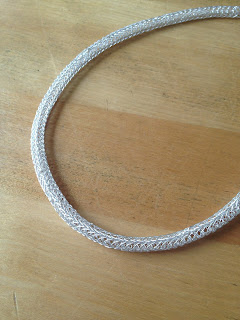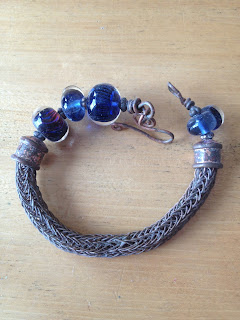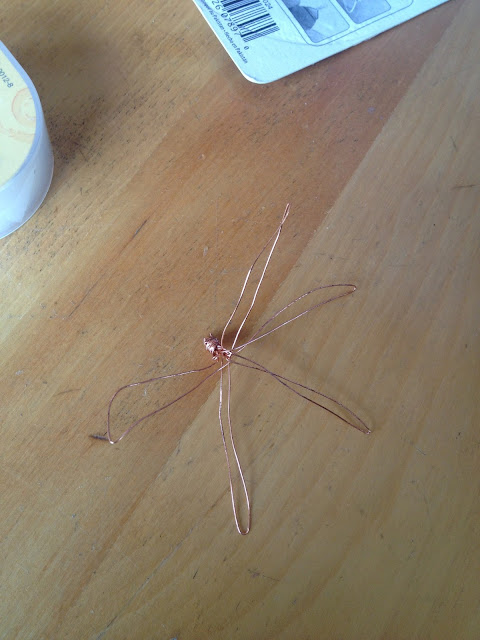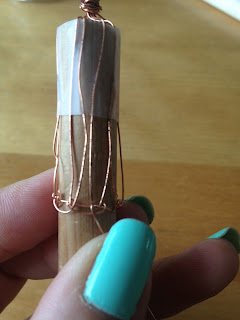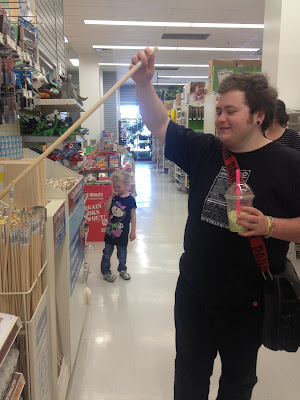Let me start this post off by saying that I wish I could provide more photos of my project. I believe Maia will be posting a blog shortly with all the completed pieces, and I only have one photo showing a "work in progress". But I did want to briefly discuss my feelings about this now that the presentation part of the assignment has been completed, especially now that we are transitioning to the research report portion.
 |
| A double strand of copper and silver-plated brass, single knit, in progress |
First off, trichinopoly is much easier than it sounds or looks. Dylyn's mother showed us how to do it in an afternoon, and the process was quite easy. While I'm not crafty enough to give proper directions, I will do my best to explain the process.
- We took a small amount of wire and wrapped it around a ruler a set amount of times (for this one, it was five, but Maia made one with three petals, and Dylyn may have made one with seven).
- Removing the ruler, we shaped the wire into petals (I had five). The petals were then folded down onto the 1/2-inch wooden dowel and kept in place with scotch tape.
- I drew two-to-three arm length pieces of wire from the spool (for my first piece, I used two, but for this one, I used three).
- Now this is where my memory gets hazy. For the first row, you take wire behind the petal, drawing it all the way through until the very end, leaving a small tail.
- Then, you pull the wire to the left and then to the right, so it makes a small loop, or a "knot". You repeat this with all other petals to make the first row.
- Now, from the second row onward, you guide the wire behind the knot you've made, continuing to make new "knots". For knitting fans, it's kind of like a "purl" stitch, since you are going behind the knot.
- Continue on until the piece is the desired length, "knitting" new pieces of wire along the way.
- The piece is then removed from the dowel. Using a pull board, the chain is pulled through each hole twice, and the holes decrease in size. As the chain is pulled through, it gets smaller and tighter until it reaches it's desired size.
I'm pretty sure my explaining lacks a few steps, which I will redress in the report. With the guidance of Dylyn's mother, I finished my first piece in a little over an hour, and finished the second in an afternoon. The first material I used appeared to be size 24 brass, and it was an easy material to use. It was easy to knit with and there were no wire breaks. I also had no problem using the 28 copper and silver (or steel)-plated wire used to make the second piece. Because the 28 was the thinnest, it required more wire to get to my desired length. But once pulled through the pull board, it resembled the pieces we've seen in our literature, which leads me to at least speculate that thin wire was probably the most preferred wire of that time period.
I really enjoyed learning how to do Trichinopoly, and I'm considering making more chains for a few pendants I have lying around my house. However, as we sat around, making pieces, I couldn't help but wonder if Trichinopoly pieces were solely done by artisans. Sadly, I have no evidence to back it up, but I wonder if this was a two part process. There were those who pulled/created (men?) the wire, and those who took that wire to create the chain (women). I could see a group of women sitting around, creating this pieces while socializing with others. From the websites I've read (again, there is no corroboration from peer-reviewed journals), Trichinopoly chains were used not only as jewelry pieces but also as trim for clothing. In this vein, it could have easily been done by normal people when making their clothes they wear, especially special outfits. But again, that just comes from my understandings and experiences in crafting, and I understand that things could have been different at that time. I will more than likely have to see about finding any other kind of literature that can help to sharpen the picture.
-N. Russell












